The Human Body Organ Systems In Detail
Humans have more complex anatomy and physiology than other living things. Our bodies are made up of different organ systems that work together to keep us alive and healthy. Each organ system has its specific job, and they all need to work together harmoniously for our bodies to function properly.
It is important to understand how the organ systems of the human body work so that we can take better care of ourselves. By understanding how our bodies work, we can make better choices about our diet, exercise, and lifestyle. This article elaborates upon six major organ systems of the human body.
1. MUSCULAR AND SKELETAL SYSTEM
The human skeletal system provides structural support to the body. It consists of bones, joints, and muscles.
The skeletal system is made of 2 parts:
- Axial Skeleton- The axial skeleton makes up the main axis of the body such as the skull, vertebral column, and bones of the chest.
- Appendicular skeleton- It consists of bones that support appendages.
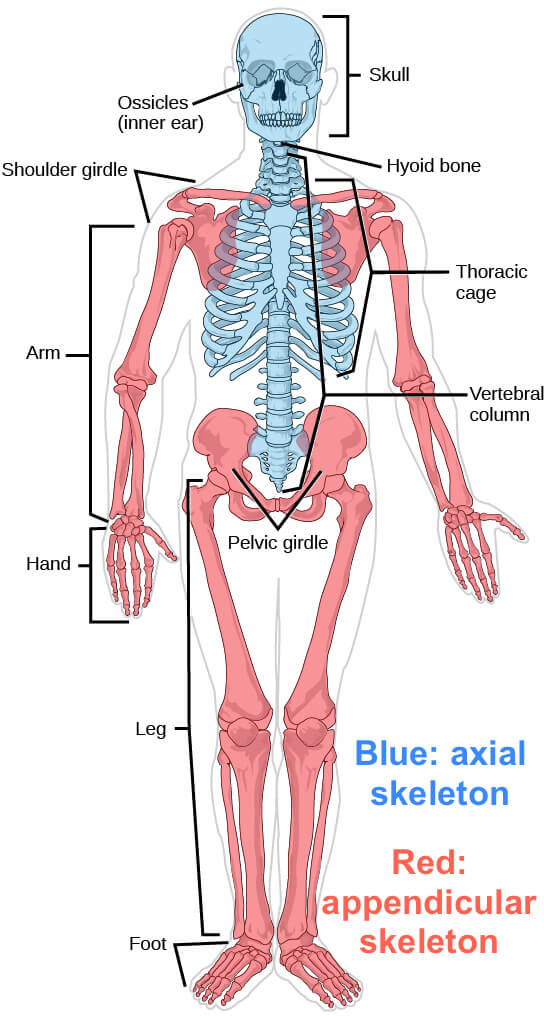
Points to Note:
- Both hands and feet have 118 bones.
- The total number of bones in the human body is 206.
- The total number of bones during childhood is 300.
- The total number of bones in the head is 29.
- The largest bone of the body is Femur (Thigh bone).
- The smallest bone of the body is Stapes (in Ears).
- Tendons connect muscles to bones.
- Ligaments connect bones to other bones.
- Ligaments are made up of yellow fibers.
2. NERVOUS SYSTEM
Under the nervous system, the nerves are spread throughout the body emitting signals and electrical impulses in response to external changes. The nervous system comprises:
- The Central Nervous System (CNS) includes the brain and spinal cord.
- The Peripheral Nervous System (PNS) connects the CNS to other parts of the body and is composed of nerves (bundles of neurons).
- The Autonomic Nervous System controls involuntary functions like breathing and heart rate.
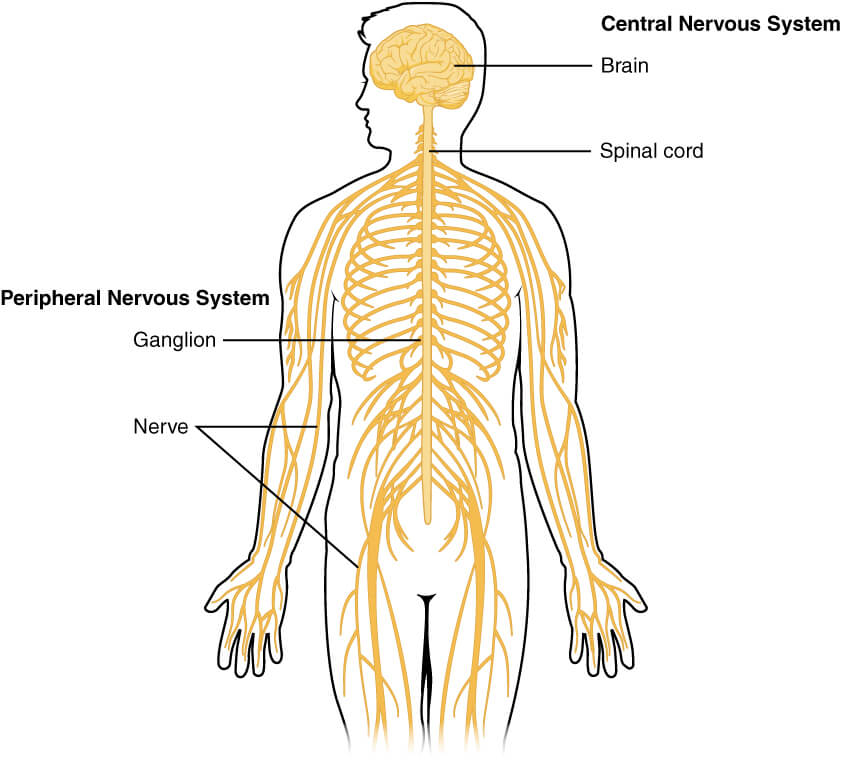
Central Nervous System (CNS)
CNS controls the whole body and is made up of 2 parts namely the brain and Spinal cord.
Brain
The brain is the most complex part of the human body. This three-pound organ is the seat of intelligence, interpreter of the senses, initiator of body movement, and controller of behaviour. The brain can be divided into three basic units:
- The forebrain- The forebrain is the largest and main thinking part of the brain. It has regions that receive sensory impulses from various receptors. Separate areas of the fore-brain are specialized for hearing, smell, sight, and so on.
- The midbrain- The Midbrain connects the forebrain to the hindbrain. It serves as a relay centre for sensory and motor pathways.
- The hindbrain- The hindbrain controls the body’s vital functions such as respiration and heart rate.
CEREBRUM: Cerebrum is a vital part of the human brain that governs our conscious experiences, sensory perception, motor control, and higher cognitive functions. It plays a fundamental role in shaping our behaviours, thoughts, and memories.
- The largest part of the human brain.
- It is at the topmost part of the brain.
- It is the source of intellectual activities.
- It holds your memories, allows you to plan, and enables you to imagine and think.
- It controls voluntary motor actions.
HYPOTHALAMUS: It serves as a link between the nervous system and the endocrine system, ensuring proper hormonal balance and coordinating essential functions for overall well-being.
• It lies at the base of the cerebrum.
• It controls the sleep and wake cycle (circadian rhythm) of the body.
• It also controls appetite and thirst.
CEREBELLUM: Cerebellum is a vital part of the brain responsible for motor control, coordination, balance, and motor learning. It works in conjunction with the cerebrum and other parts of the brain to enable smooth and precise movements necessary for daily activities. It lies below the cerebrum and at the back of the whole structure.
MEDULLA: The medulla oblongata, commonly referred to as the medulla, is a crucial part of the human brainstem. It is situated at the base of the brain, serving as a connection between the spinal cord and the rest of the brain. Its primary role revolves around regulating vital functions and facilitating the transmission of sensory and motor information between the brain and the spinal cord.
THALAMUS
• A major clearinghouse for information going to and from the spinal cord and the cerebrum.
• Cerebrospinal fluid (CSF) is a watery fluid that circulates through the brain’s ventricles (cavities or hollow spaces) and around the surface of the brain and spinal cord.
3. THE CIRCULATORY SYSTEM
The circulatory system is responsible for circulating blood throughout the body for the proper functioning of the system. It consists of:
- Heart
- Arteries
- Veins
- Blood
HUMAN HEART
The human heart is an organ that pumps blood throughout the body via the circulatory system, supplying oxygen and nutrients to the tissues and removing carbon dioxide and other wastes. The human heart has four chambers:
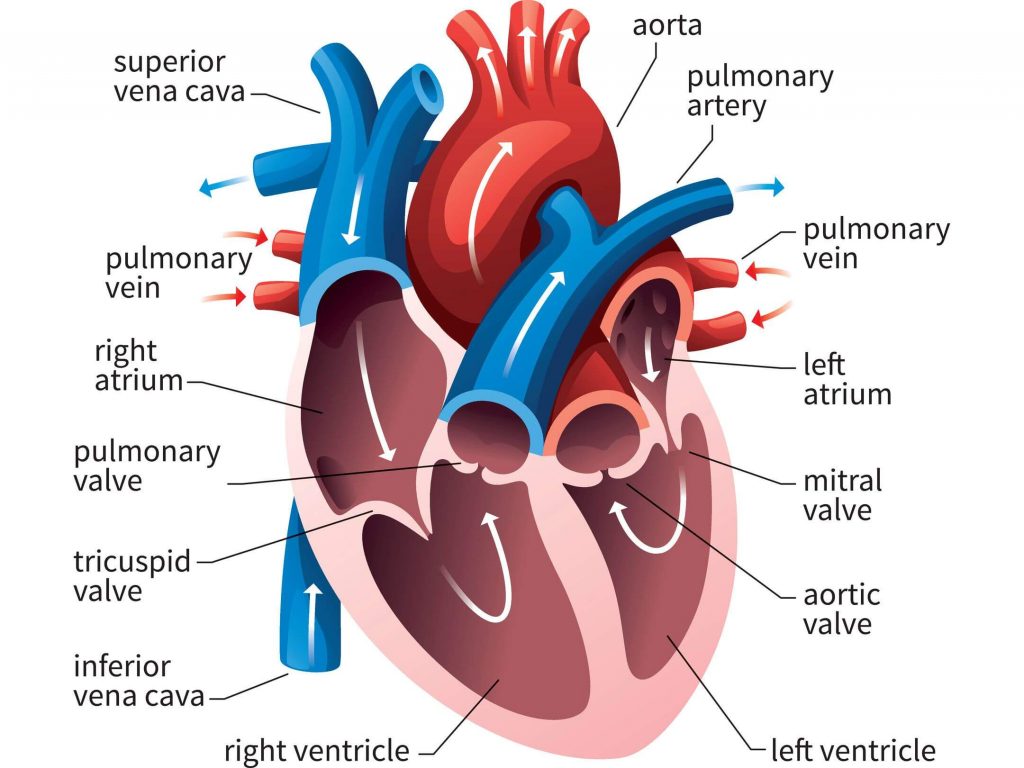
- The right atrium and right ventricle together make up the “right heart”.
- The left atrium and left ventricle make up the “left heart”.
- A wall of muscle called the septum separates the right and left atrium.
- Valves prevent backflow, keeping the blood flowing in one direction through the heart.
- A double-walled sac called the pericardium encases the heart, which serves to protect the heart and anchor it inside the chest.
- Between the outer layer, the parietal pericardium, and the inner layer, the serous pericardium, runs pericardial fluid, which lubricates the heart during contractions and movements of the lungs and diaphragm.
- The heart’s outer wall consists of three layers:-
– The outermost wall layer or epicardium, is the inner wall of the pericardium.
– The middle layer or myocardium, contains the muscle that contracts.
– The inner layer or endocardium, is the lining that contacts the blood. - The Sinoatrial node produces the electrical pulses that drive heart contractions.
Functioning of the Human Heart
The heart circulates blood through two pathways:
1. The pulmonary circuit
2. The systemic circuit
- In the pulmonary circuit, deoxygenated blood leaves the right ventricle of the heart via the pulmonary artery and travels to the lungs, then returns as oxygenated blood to the left atrium of the heart via the pulmonary vein.
- In the systemic circuit, oxygenated blood leaves the body via the left ventricle to the aorta, and from there enters the arteries and capillaries where it supplies the body’s tissues with oxygen. Deoxygenated blood returns via veins to the vena cava, re-entering the heart’s right atrium.
Important Points
- Aorta- The largest artery in the body. It carries oxygen-rich blood away from the heart to vessels that reach the rest of the body.
- Atria- The chambers of the heart, to which the blood returns from circulation.
- Capillaries- The smallest of the body’s blood vessels. Oxygen and glucose pass through capillary walls and enter the cells. Waste products such as carbon dioxide pass back from the cells into the blood through capillaries.
- Cardiac Valves (Heart Valves)- Any of the four heart valves that regulate the flow of blood through the chambers of the heart.
- Oxygenated Blood – Oxygen-rich blood.
- Deoxygenated Blood – Oxygen-poor blood.
- Heart Ventricles – The lower right and left chambers of the heart.
- Interventricular septum is the stout wall separating the lower chambers (the ventricles) of the heart from one another.
- Lungs- One of a pair of organs in the chest that supplies the body with oxygen, and removes carbon dioxide from the body.
- Myocardium- The muscular substance of the heart; the middle of the three layers forming the outer wall of the human heart.
- Pulmonary Artery- The pulmonary artery and its branches deliver blood rich in carbon dioxide (and lacking in oxygen) to the capillaries that surround the air sacs.
- Pulmonary Circulation- The circulation of the blood through the lungs.
- Pulmonary Veins- The veins that return the oxygenated blood from the lungs to the left atrium of the heart.
- Superior Vena Cava- The large vein that carries blood from the head, neck, arms, and chest to the heart.
- Vena Cava- A large vein that returns blood from the head, neck, and extremities to the heart.
4. THE DIGESTIVE SYSTEM
The human digestive system is a coiled, muscular tube which is 6-9 meters long when fully extended stretching from the mouth to the anus.
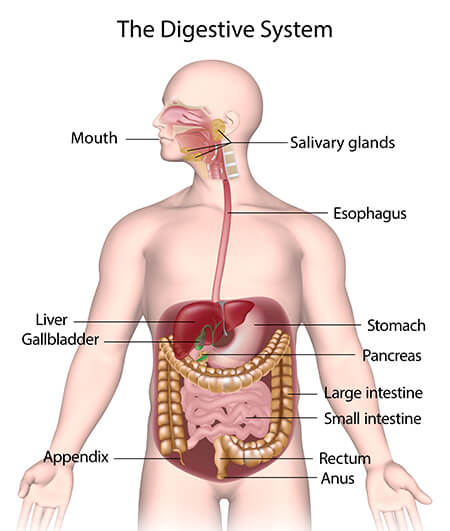
The Mouth and Pharynx
The chemical breakdown of starch by the production of salivary amylase from the salivary glands into glucose. This mixture of food and saliva is then pushed into the pharynx and Oesophagus.
The Stomach
Gastric juice in the stomach contains:
• Hydrochloric acid(HCL),
• Pepsinogen, and
• Mucus
Functions of Hydrochloric acid(HCL) :
- It kills microorganisms.
- It lowers the stomach pH to between 1.5 and 2.5
- It lowers the pH of the stomach so pepsin is activated.
- Pepsinogen is an enzyme that starts protein digestion and controls the hydrolysis of proteins into peptides.
- Chyme, the mix of acid and food in the stomach, leaves the stomach and enters the small intestine.
- Alcohol and aspirin are absorbed through the stomach lining into the blood. Epithelial cells secrete mucus that forms a protective barrier between the cells and the stomach acids.
Small Intestine
The small intestine is the major site for digestion and absorption of nutrients.
- It is about 22 feet (6.7 meters) long.
- Parts of the small intestine:
1. Duodenum
2. Jejunum
3. Ileum - Sugars and amino acids go into the bloodstream via capillaries in each villus.
- Glycerol and fatty acids go into the lymphatic system.
- Starch and glycogen are broken down into maltose by small intestine enzymes.
- Maltose, sucrose, and lactose are the main carbohydrates present in the small intestine; they are absorbed by the microvilli.
5. THE EXCRETORY SYSTEM
The urinary system is made up of the kidneys, ureters, bladder, and urethra. The Nephron, an evolutionary modification of the nephridium, is the kidney’s functional unit.
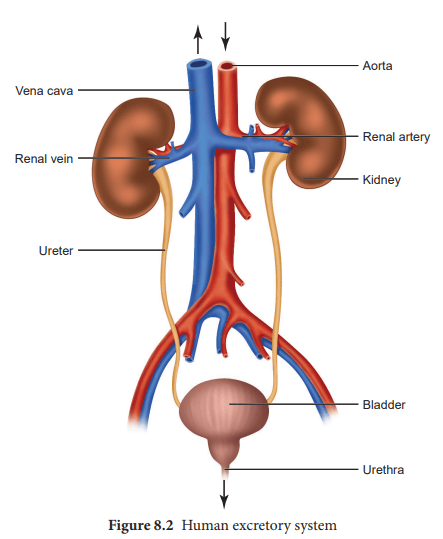
The Nephron has three functions:
1. Glomerular filtration of water and solutes from the blood.
2. Tubular reabsorption of water and conserved molecules back into the blood.
3. Tubular secretion of ions and other waste products from surrounding capillaries into the distal tubule.
6. THE ENDOCRINE SYSTEM
The endocrine system is made up of glands that produce and secrete hormones, chemical substances produced in the body that regulate the activity of cells or organs. These hormones regulate the body’s growth, metabolism (the physical and chemical processes of the body), and sexual development and function.
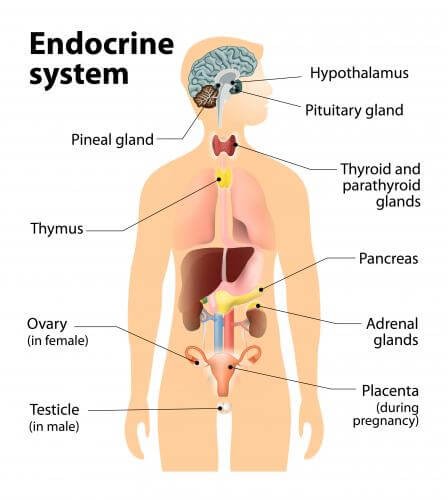
Adrenal gland:
The adrenal glands (also known as suprarenal glands) are endocrine glands that produce a variety of hormones including adrenaline. They are found above the kidneys.
Hypothalamus:
The hypothalamus is a portion of the brain that contains several small nuclei with a variety of functions.
Function: Links the nervous system to the endocrine system via the pituitary gland.
Pituitary Gland:
The pituitary gland (often called the master gland) is located in a small bone cavity at the base of the brain. It is an endocrine gland about the size of a pea and weighs 0.5 grams in humans. Hormones secreted from the pituitary gland help control:
• growth
• blood pressure
• certain functions of the sex organs
• metabolism
• pregnancy
• childbirth
• nursing
• water/salt concentration
• temperature regulation
• pain relief
Thyroid:
The thyroid gland, or simply the thyroid is one of the largest endocrine glands in the body.
- It secretes two hormones: thyroxine or tetraiodothyronine (T4) and triiodothyronine (T3). Both hormones contain iodine.
- Hypothyroidism (hypo, ‘under’)–diminished thyroid activity. Hypothyroidism in childhood gives rise to a condition called cretinism.
- It controls the rate of use of energy sources, protein synthesis, and the body’s sensitivity to other hormones.
- Goitre – It is called enlargement of the thyroid gland. It manifests itself as a swelling in the neck. A goitre may be associated with increased, normal, or decreased activity of the thyroid gland.
Pancreas:
The pancreas is a glandular organ in the digestive system and endocrine system of vertebrates. In humans, it is located in the abdominal cavity behind the stomach. It produces several important hormones:
• Insulin
• Glucogen
• Somatostatin, and
• Pancreatic Polypeptide which circulates in the blood.
The pancreas is also a digestive organ, secreting pancreatic juice containing digestive enzymes that assist digestion and absorption of nutrients in the small intestine.
| Also Read: | |
| States and Capitals | Prime Ministers of India |
| Union Territories in India | National Symbols of India |

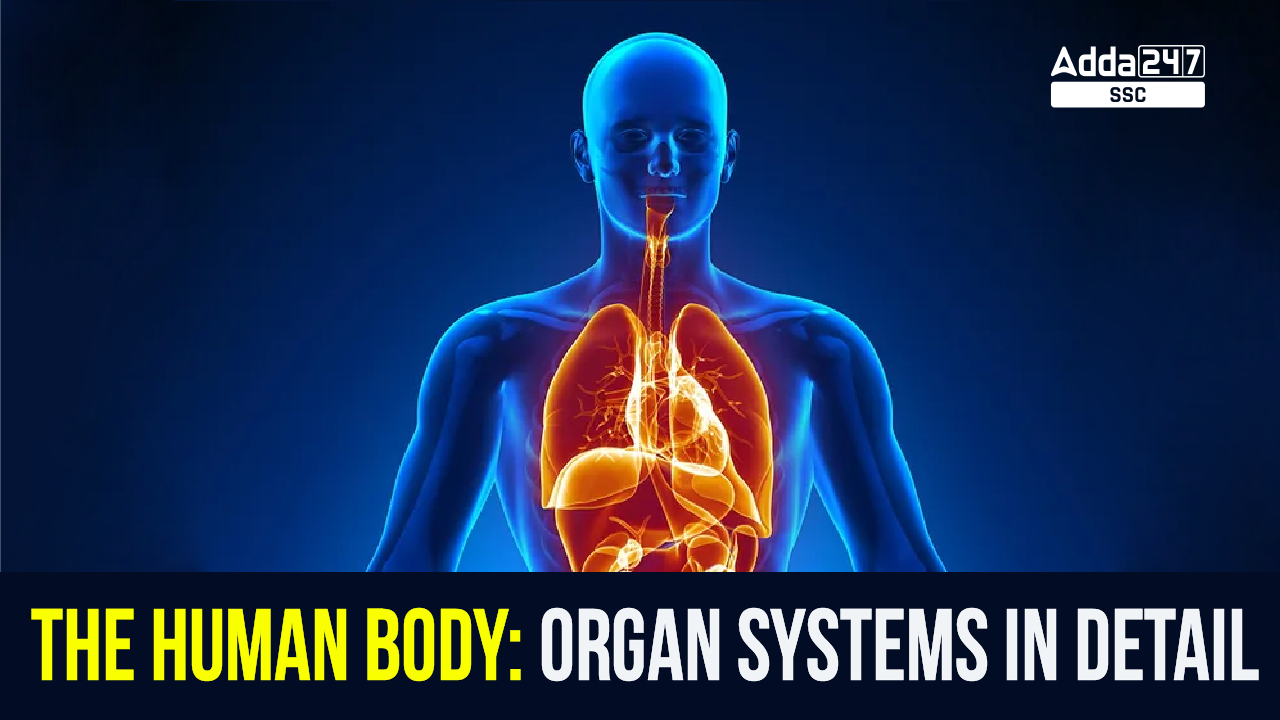

 Importance of Solving Previous Year Pape...
Importance of Solving Previous Year Pape...
 SSC CHSL Vs. SSC CGL – What Changes in S...
SSC CHSL Vs. SSC CGL – What Changes in S...
 RRB ALP Preparation Strategy 2025, Tips ...
RRB ALP Preparation Strategy 2025, Tips ...


